Common menu bar links
Breadcrumb Trail
ARCHIVED - RCMP External Review Committee
 This page has been archived.
This page has been archived.
Archived Content
Information identified as archived on the Web is for reference, research or recordkeeping purposes. It has not been altered or updated after the date of archiving. Web pages that are archived on the Web are not subject to the Government of Canada Web Standards. As per the Communications Policy of the Government of Canada, you can request alternate formats on the "Contact Us" page.
SECTION II: ANALYSIS OF PROGRAM ACTIVITIES BY STRATEGIC OUTCOME
Strategic Outcome
The 2008-09 Report on Plans and Priorities has one Strategic Outcome:
The Royal Canadian Mounted Police External Review Committee aims to positively influence the manner in which labour relations issues are addressed within the Royal Canadian Mounted Police.
To achieve its Strategic Outcome, the ERC has identified two Program Activities:
1. Independent and impartial case review
2. Outreach and information dissemination
Program Activity by Strategic Outcome
|
2008-09 Financial Resources ($ thousands) |
2008-09 Human Resources (FTEs) |
||||
|---|---|---|---|---|---|
|
Planned Spending |
Total Authorities |
Actual Spending |
Planned | Actual | Difference |
| 1,189 | 1,235 | 1,191 | 8* | 8 | 0 |
|
Expected Results |
Performance Indicators |
Targets |
Performance Status |
Performance Summary |
|---|---|---|---|---|
| Parties and RCMP Commissioner are provided with an independent review of the dispute to facilitate transparent and accountable dispute resolution. | Percentage of cases where findings and recommendations are issued. | 100% of referred files, subject to Grievor's right to withdraw | Met all | 31 findings and recommendations were issued and no cases were withdrawn. |
| A body of findings and recommend- ations is created to assist RCMP Level 1 Adjudicators, parties, RCMP Commissioner and staff representatives to interpret legislation, regulations and policy. | Number of times legislative, regulatory or policy interpretative guidance provided in findings and recommendations. | As required | Met all | All relevant reports have been appended to the growing knowledge base maintained in the ERC website which has been upgraded in compliance with TBS Common Look and Feel Directive. |
| Identification of areas for legislative, regulatory or policy change/clarification . | Number of recommendations for change/clarification provided in findings and recommend- ations. | As required | Somewhat met | This measure applies only when such findings are identified. This number was statistically insignificant in this year. |
* 1 FTE is for 9/12th of the year.
The ERC concludes matters referred to it by the RCMP either on the basis of the material in the record or following a hearing. In conducting its reviews, the ERC attempts to achieve timeliness and quality in its analysis and recommendations, and an equitable balance between all of the interested parties. It relies on the principles of administrative and labour law and it respects the remedial approach indicated by the RCMP Act. In each case, the ERC considers the public interest along with the members' interest in fair and equitable treatment.
The statutory mandate of the ERC in the RCMP Act is case review and it is in this respect that program activity 1 supports priority 1.
Benefits for Canadians
Canadians are served through the ERC's contribution to fair, transparent and accountable labour relations processes within the RCMP. They are assured that RCMP members are treated by Canada's national police force as would be expected by Canadians whose tax revenues support it.
Performance Analysis
Case Review
Referrals
Twenty-two cases were referred to ERC in 2008-2009: 18 grievances and 4 disciplinary appeals. The ERC received no referrals of discharge and demotion appeals this year.
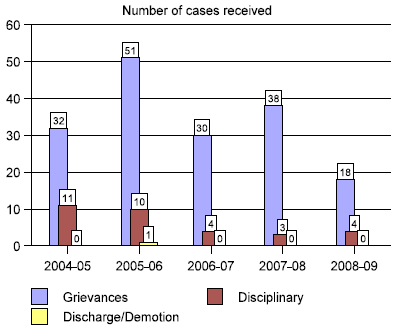
Cases Completed and Recommendations Issued
The ERC completed 31 cases in 2008-2009: 28 regarding grievances and 3 regarding disciplinary appeals.
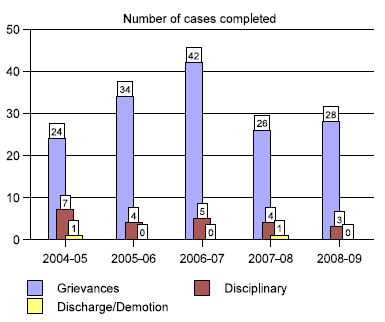
Grievances
The chart below shows the distribution of this year's grievance recommendations by subject matter.
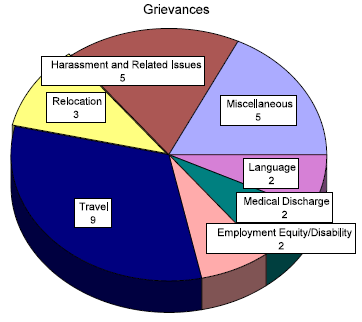
Performance Improvement
Over the years the complexity of the Force's employment policy suite has grown. Similarly, the files referred to the ERC have increased in volume and complexity. The ERC has taken steps to reduce the time to analyse each file - the sole factor within its control. Since 2003, the average analysis time has decreased. Nonetheless, despite the ERC's efforts, the idle time - from receipt of the file to the start of the analysis - continued to increase.
As a result of additional short term funding that the ERC received, there were immediate and measurably positive results. The average idle time for files referred to the ERC decreased in the year that resources were deployed. While the trend in the idle time has leveled out, the ERC is continuing to improve its processing time. The graph below illustrates this trend as well as the positive results of the ERC's continued efforts to reduce both the processing time as well as the idle time.
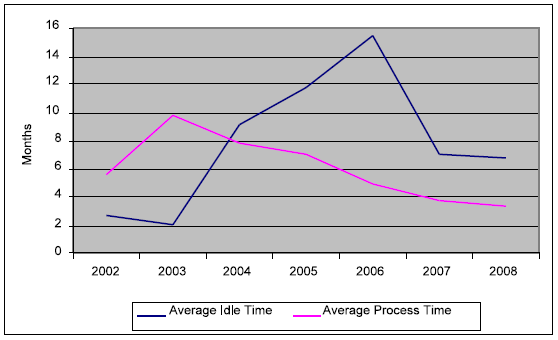
For grievances, the ERC's ideal objective is to issue its findings and recommendations within three months of the case being referred to it. For discipline and discharge and demotion cases, the ERC strives for a standard of six months. These service standards are not currently being met.
At the start of 2008-09, 69 grievances and appeals were pending before the ERC. At the fiscal year end of 2008-09, there were 60 cases before the ERC for review. Two-thirds of these cases were referred to the ERC more than one year before, and one-quarter were referred more than two years before. They were distributed as follows:
- 48 pending grievances; and
- 12 pending disciplinary appeals.
Other Activities
The ERC's workload includes significant reporting and corporate requirements. Unlike most departments and agencies, the ERC has no specialists in areas such as procurement, finance, human resources and knowledge management. As a result, staff members assume many duties to address corporate management demands in order to meet the same reporting requirements of a large department. These reporting pressures contribute to delays in the case review process.
Lessons Learned
From this year's analysis the ERC can say with certainty that its operational capacity has improved.
Previously its small complement of full time staff had been challenged to meet the expectations of central reporting agencies at the same time as discharging its statutory mandate. In the prior year, the ERC temporarily realigned its staff to ensure that there was support for strategic corporate planning and reporting, in response to an immediate need, but only at the expense of case review.
The Limitations of Temporary Funding
A variety of issues prevented the ERC from fully exploiting its temporary additional funding to the extent anticipated. The ERC experienced barriers through the classification process, the staffing process, and the professional services procurement process .
Staffing choices were limited because of the determinate nature of the funding. Candidates were less inclined to participate in a staffing process for a determinate position, and they were similarly motivated to leave the ERC's determinate positions for indeterminate ones elsewhere in the public service.
The ERC having no specialist capacity in these processes found that the processes themselves, diverted staff from their established duties.
Keeping up with increased Corporate Support demands
The ERC is subject to the same accountability and reporting requirements as large departments. Greater demands from central agencies for management accountability reporting has increased the resources that departments must allocate to corporate functions. Increased corporate pressures apply equally to the ERC.
As the ERC has few corporate resources, it was required to reassign staff from case review to address mandatory governance initiatives. The additional funding of limited duration has been of assistance.
|
2008-09 Financial Resources ($ thousands) |
2008-09 Human Resources (FTEs) |
||||
|---|---|---|---|---|---|
|
Planned Spending |
Total Authorities |
Actual Spending |
Planned | Actual | Difference |
| 296 | 317 | 202 | 2* | 1** | -1 |
|
Expected Results |
Performance Indicators |
Targets |
Performance Status |
Performance Summary |
|---|---|---|---|---|
| Make available information to the public on labour relations issues within the RCMP to support accountability and transparency. | Subscription levels for quarterly Communiqu�; subscription levels for annual report; Website traffic; volume of requests for information. | ERC is committed to maintaining current levels | Exceeded | While levels of engagement with the RCMP have been maintained across the various measures, the upgrade to its website has contributed to an increase much higher than anticipated. |
| Increase awareness of labour relations issues and resolutions within RCMP Policy. | Website access statistics; subscription and distribution data; number of requests for information; number of outreach events. | ERC is committed to maintaining current levels | Exceeded | Increased traffic indicates a greater accessibility as well as a greater than expected increase in awareness. |
* 1 FTE is for 9/12th of the year.
** External service provider was used in place of 1 planned FTE for this fiscal
year.
The ERC strives to make information available in a timely and accessible way, with the objective of influencing in a positive way the RCMP labour relations environment, and contributing to the disciplines of administrative and labour law.
Summaries of the ERC's findings and recommendations in each case, as well as articles of interest, relevant legal principles and information on related issues, are distributed widely. Communication and outreach tools include: a quarterly publication (Communiqué); a Website with up-to-date inclusion of publications and case summaries; the Annual Report; and presentations, meetings, offered training and other outreach activities.
This part of the ERC's work is dedicated to program activity 2, and it directly supports priority 2.
Performance Analysis
Requests for Information
In 2008-09, the ERC received a total of 113 requests for information. On average, the ERC provided an answer to each such request within 4 days. Over one third of the requests came from the RCMP itself. Members of the public were the second largest group of requesters.
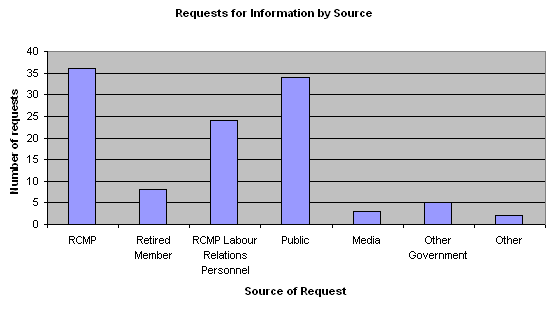
The graph below illustrates the range of general categories of requests received. Several requests were straightforward and the requesters were given appropriate information and direction. However other requests were complicated and required more time and effort for a complete and accurate response. By far, the median response time was one day, indicating that a small number of complex inquiries was significantly time-consuming.
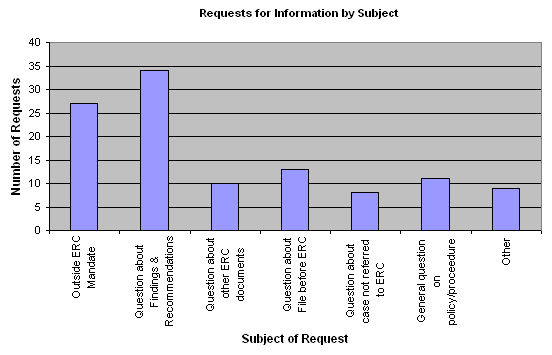
Lessons Learned
The ERC is aware that it has given priority to its case review function above outreach and information dissemination. Nonetheless, it appears that a significant performance improvement can be realized in this area through the use of modern technology. With some effort, the ERC will investigate the benefits of expanding the current use of technology to disseminate information.
